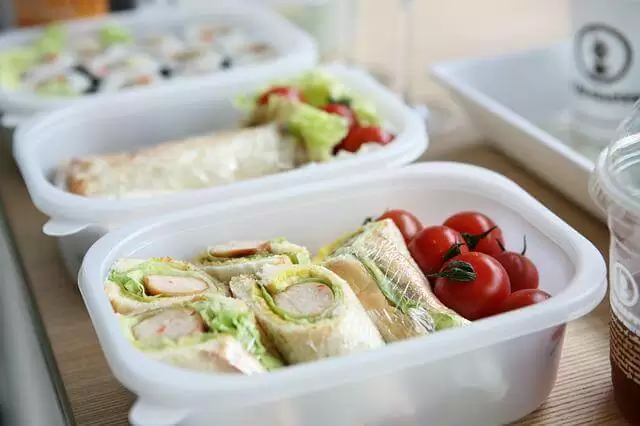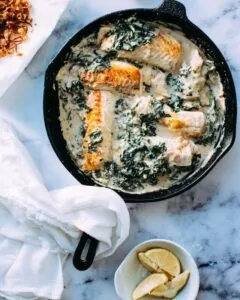It’s a fact that we can’t imagine living our day-to-day lives without electricity.
With the fridge functioning, preserving food in hot weather is easier.
However, sometimes you don’t have access to electricity or other power sources; you might fret about how to keep food cold without a fridge.
Whether your fridge is broken or your power is out, there are numerous methods to keep food cold without a fridge.
Today, I’ll tell you the most effective ways to keep lunch cold without refrigeration. You can utilize these methods in times of emergency.

Table of Contents
ToggleHow To Keep Food Cold Without A Fridge?
Use these methods to keep your food cold when your fridge is not functioning.
1. Store Food In The Cooler Areas Of Your Residence
The easiest fashion to keep your food and drinks cool is to find cooler areas in your residence.
For example, if you have a basement in your house, it will be cooler than the home’s second story.
You can also utilize a well or find a cave in your house.
Just remember to put your food in air-tight containers so that critters don’t consume all your food.
2. Use Solar Oven
The next way of how to keep food cold when fridge is broken is to use solar ovens.
Most people use solar ovens to warm their food when electricity is absent.
However, very few folks know that solar ovens can also be utilized to keep the food cool and make ice at night.
First, put a container in the oven with two bags around it filled with water.
Place the water into the container; the outcome will be ice or cold water that you can use during the day to keep your food cool.
Otherwise, you can place the food directly into the container to keep it cool during the night.
Also Read: How To Fix Grainy Buttercream Frosting? 5 Effective Methods

3. Use A Cooler
Coolers are the most common way to keep food cold without a fridge. They work by trapping cold air inside, and they can be used to keep food cold for hours or even days.
To use a cooler effectively, be sure to pre-chill it before adding food. You can do this by filling it with ice or ice packs and letting it sit for a few hours.
Then, pack your food tightly inside the cooler, keeping cold foods together and frozen foods at the bottom.
You can also extend the life of your ice by packing it in layers of towels or newspaper. This will aid in insulating the ice and prevent it from melting too quickly.
Coolers are great for outdoor camping trips and other outdoor adventures. It can keep everything from a cheesesteak to sodas cool for long periods of time. There’s no need to sacrifice
4. Use Ice Packs
Ice packs are another great way how to keep things cool without a fridge. They’re reusable and can be kept in the freezer until needed.
To use an ice pack, place it in a cooler or directly on top of your food.
Ice packs are impeccable for keeping food cold for short periods, such as during a picnic or a car ride.
5. Use Dry Ice
It is a solid form of carbon dioxide that is much colder than regular ice. It’s often used to ship frozen food, but it can also be used to keep food cold without a fridge.
To use dry ice, be sure to wear gloves and handle it carefully. Dry ice can cause frostbite, so keeping it away from your skin is vital.
Place it in a cooler or a cardboard box lined with newspaper. Then, pack your food around it. Be sure to keep the dry ice at the bottom of the cooler or box, and keep it away from any food that is high in moisture.
Dry ice can keep food cold for several days, but it’s essential to check on it regularly to ensure it hasn’t melted completely.
Also Read: How To Reheat Pizza In Toaster Oven
6. Use A Swamp Cooler
A swamp cooler is a device that utilizes evaporation to cool air. It’s an excellent way to keep food cold in hot and humid climates.
To use a swamp cooler, fill it with water and place it near your food. The swamp cooler will evaporate the water, which will cool the air around it.
Swamp coolers are especially effective in keeping food cold if you place them in a shady spot.
7. Use A Clay Pot Cooler
Clay pot coolers are a traditional way to keep food cold. They work by evaporating water from the clay, which cools the air inside the pot.
To use a clay pot cooler, fill the pot with cold water and place it in a well-ventilated area. You can then place your food inside the pot.
Clay pot coolers are most effective in dry climates. In humid climates, they may be unable to cool the air enough to keep food cold.
8. Use A Root Cellar
Root cellars are underground rooms that are used to store food. They are naturally cool and humid, which makes them ideal for storing fruits, vegetables, and other perishable foods.
To build a root cellar, you will need to dig a hole in the ground and line it with concrete or brick.
The hole should be deep enough to stay cool year-round, and it should have a drainage system to prevent water from accumulating.
Once the root cellar is built, you can start storing your food. Be sure to wrap all fruits and vegetables in paper or cloth to prevent them from drying out.
9. Use A Cold Spring
If you live near a cold spring, you can use it to keep food cold. Simply place your food in a container and submerge it in the spring water.
The cold spring water will keep your food cold for hours or even days.
10. Use A Thermal Bag
A thermal bag is a great alternative to a fridge. It’s portable and can keep food cold for several hours.
You can utilize it to store perishable items like meat, dairy, fruits, and vegetables.
Also Read: How To Plan A BBQ Party: 4 Tips For A Successful Barbecue Party
11. Use A Well
If you have a well on your property, you can use it to keep food cold. Place the food in a bucket or basket and lower it into the well.
The cold water will help to keep the food cold. Guarantee to check the food periodically to ensure that it is staying cold.
You may also want to place the food in a sealed container to prevent it from getting wet.
12. Reconsider Your Food Storage
Most people go to the grocery shop and purchase adequate food for a month.
Then, they add all the food to the fridge. Then, over the month, they add some leftovers to the refrigerator and let them sit there for several days.
You need to change this thinking line when you cannot use your fridge.
Most fresh produce doesn’t need to be frozen. Also, it is better not to buy perishable foods in bulk.
It’s one of the most effective ways of how to keep food cold without electricity.
How To Store Food Without Fridge?
Storing food without a fridge can be challenging, but it is possible with some planning and care. Here are a few tips to keep in mind:
- Choose the right location: When storing food without a fridge, it is crucial to choose a cool, dark place. This could be a basement, pantry, or even a shady spot outside. Avoid storing food in direct sunlight or hot, humid areas.
- Use the correct containers: Food should be stored in clean, airtight containers. This will help to prevent it from spoiling and attracting pests.
- Be mindful of cross-contamination: Keeping raw and cooked foods separate to prevent cross-contamination is essential. This could lead to food poisoning.
- Check food regularly: When storing food without a fridge, it is essential to check it regularly for signs of spoilage. This includes checking for discoloration, mold, and off-odors.
Here Are Some Additional Tips For Storing Specific Types Of Food Without A Fridge:
- Fruits and vegetables: Several fruits and vegetables can be stored without a fridge for several days. However, some fruits, such as bananas, avocados, and mangoes, produce ethylene gas, which can cause other fruits and vegetables to ripen and spoil swiftly. Store these fruits separately from other fruits and vegetables.
- Dairy products: Dairy products, like milk, cheese, and yogurt, should be stored in a cool, dark place. Store them in the coldest part of your house, such as a basement or pantry.
- Meat and poultry: You should store meat and poultry in the coldest part of your house, like a basement or pantry. Keep them in a sealed container or bag to inhibit them from drying out.
- Cooked foods: Cooked foods should be stored in a sealed container and refrigerated or frozen as soon as possible. If you do not have a fridge, you can store cooked foods in a cool, dark area for up to 2 hours.
Also Read: How Much Is 3/4 Teaspoon Of Baking Soda
What Temperature Does Food Need To Be Kept?
Food needs to be kept at the right temperature to prevent the growth of harmful bacteria.
Bacteria can grow quickly in the temperature range of 40°F to 140°F, which is known as the “danger zone.” When food is in the danger zone for more than two hours, it is unsafe to eat.
The ideal temperature to store food is below 40°F. This can be done by refrigerating or freezing food.
According to the U.S. Food and Drug Administration, it is recommended that refrigerators should be set to 40°F (4.4°C) or below, and freezers should be set to 0°F (-18°C) or below.
Here Are Some Tips For Keeping Food At The Right Temperature:
- Refrigerate or freeze food within 2 hours of cooking or purchasing.
- Keep food in airtight containers or bags. This will assist in preventing moisture loss and contamination.
- Do not overcrowd the refrigerator or freezer. This will prevent air from circulating and can cause food to spoil more quickly.
- Check your refrigerator and freezer’s temperature regularly to ensure they are at the correct temperature.
Here Are Some Specific Temperature Guidelines For Storing Different Types Of Food:
- Meat, poultry, and seafood: These foods should be stored at 40°F or below. Raw meat, poultry, and seafood can be stored in the refrigerator for up to two days. Cooked meat, poultry, and seafood can be kept in the refrigerator for four days.
- Dairy products: Dairy products should be kept at 40°F or below. Milk can be stored in the refrigerator for seven days. Yogurt can be stored in the refrigerator for up to two weeks. Cheese can be stored in the refrigerator for up to one month.
- Fruits and vegetables: Most fruits and vegetables can be stored in the refrigerator for up to one week. However, some fruits, such as bananas, avocados, and mangoes, should be stored at room temperature.
How To Keep Veggies And Fruits Cool Without A Fridge?
- Store veggies with their stems and put them in a pot of water for at least two days.
- Wrap herbs in a wet rag and put them in an airtight jar.
- Store cabbage, cucumber, eggplant, and avocado on the counter for 3 to 4 days.
- You can dehydrate veggies and fruits and store them in glass containers in your storeroom.
- Don’t wash the greens before storing. It’s better to keep them dry.
- Keep dates, pears, tomatoes, melons, peppers, etc., on the counter for two weeks.
- Store garlic, apples, and potatoes in a cool dark area for 30 days.
- If the carrots become rubbery, peel and soak them in water to make them crisp again.
Also Read: 5 Best Kitchen Gadgets Ever That Actually Save Time In The Kitchen
How To Store Dairy Without A Fridge?
- The best way of how to keep milk cold without a fridge is to drink it the day you purchase it.
- Alternatively, you can utilize it to make kefir or sour cream.
- Hard cheese and butter will last for 14 days in a cool area.
- A study on how to keep food cold without a fridge camping suggests that the yogurt can last for 6-7 days before molding.
How To Keep Meat And Eggs Cold Without A Fridge?
- The ideal way of how to keep food cold while traveling is to purchase vacuum pepperoni and salami.
- Always buy meat and eggs in smaller servings.
- Leave eggs unwashed before using them.
- Cook meat on low. Place the leftovers into the container and convert them into soup for the next day.
Frequently Asked Questions
1. How Do You Keep Food Refrigerated Without A Refrigerator?
Keeping food cool without a fridge might seem challenging, but it’s entirely doable. Consider using insulated containers, ice packs, or even nature’s cooling methods like shade and cool outdoor temperatures. Layering your items strategically and pre-chilling them can also go a long way in maintaining their freshness.
2. Can You Keep Food Cold Without A Fridge?
Absolutely! There are several creative ways to keep your food cold without the need for a traditional fridge. Insulated bags or coolers, DIY ice packs, and leveraging natural cooling methods are all effective strategies. The key is to plan ahead, use the right containers, and take advantage of available resources like shade and cooler outdoor temperatures.
3. What Can I Use Instead Of A Fridge?
Without a fridge, you can explore alternative methods to keep your food cold. Insulated coolers or bags, cool packs, and even using wet cloths for evaporation-based cooling are excellent options. Additionally, strategic placement in your car, pre-chilling your items, and using available resources smartly can help maintain your food’s freshness without a traditional refrigerator.
Conclusion
Knowing how to keep food cold without a fridge can preserve your food supply and wallet.
By using the methods mentioned above, you can easily keep your food fresh for a prolonged period.
So, try to use how to keep food cold in car without a cooler methods during your next camping or emergency period of a power outage.
You May Also Like To Read
- How To Eat Healthy Food Everyday
- How To Unsalt Food
- How Many Slices Is A 12 Inch Pizza
- How Long Does It Take For A Cake To Cool
- How To Heat Up Food Without Microwave
- How To Stop Craving For Junk Food
- Good Family Dinner Recipes











